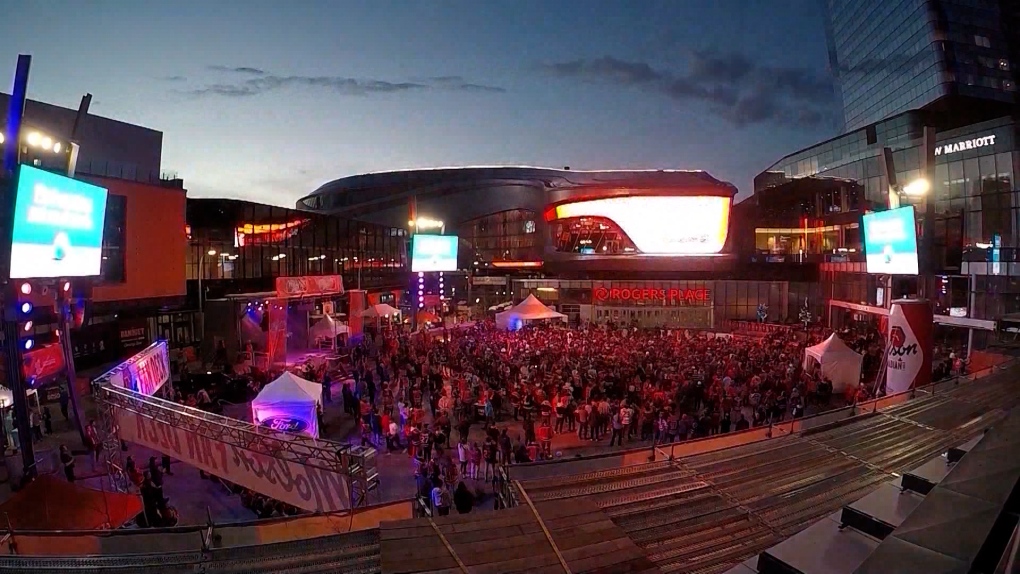10 years after construction started, Edmonton’s Ice District ‘a model in pro sports’

Ten years ago, heavy equipment was brought in to a plot of vacant downtown land to start construction of the catalyst for one of the most transformative projects in Edmonton history: Ice District.
Today, it’s the epicentre for many major city events, including NHL playoff hockey, something that’s become a spring staple.
“We always thought by bringing the arena downtown that we could get people coming earlier and staying later, that the arena and the plaza could be the heartbeat of downtown. I really think that’s what it’s become,” Tim Shipton, the Oilers Entertainment Group’s executive vice-president of communications and gaming, told CTV News Edmonton.
That vision has transformed the area once dominated by surface parking lots and empty land into a state-of-the-art hockey and concert venue surrounded by restaurants, shops and mixed-use high-rises, including the 66-storey Stantec Tower, the tallest building in Canada outside Toronto.
“Ice District coming out of the ground, I think it’s a source of pride for all of us,” Shipton said. “It’s a source of pride for the community.”
In 2012, Oilers owner Daryl Katz unveiled plans for the sports and entertainment district.
A year later, the Katz Group and the city came to a deal.
In March 2014, crews broke ground on the parcel of land north of 104 Avenue between 102 and 104 streets to officially begin construction of the arena that was finished on time almost two-and-a-half years later in September 2016.
The Stantec Tower opened two years later followed by the luxury 55-storey J.W. Marriott building in 2019.
“We’ve built at a pace not seen anywhere in North America,” Shipton said.
“It’s remarkable to see billions of dollars invested in a short decade, which, in development time, really is a short amount of time.”
The deal to build the arena and the surrounding district was controversial.
The total bill was $613.7 million, $483.5 million of that for Rogers Place itself.
The Katz Group paid $132.5 million for its share of the arena cost, with $112.8 million of its contribution being paid to the city as rent over 35 years. The city paid $226 million for its portion of Rogers Place construction costs, including funding from a community revitalization levy (CRL), a redirected subsidy from the former Rexall Place and new parking revenue.
A ticket surcharge was implemented for $125 million of funding
They also divvied up the cost for construction of the $56.8-million Winter Garden, which is now known as Ford Hall, with the Katz Group paying $31.7 million — $25 million of it as rent to the city over 35 years —and the city contributing $25.1 million.
The overall price also included the Downtown Community Arena, an LRT connection and a pedestrian corridor — paid for chiefly by the city, with contributions from the federal government and MacEwan University — and land costs.
The provincial government declined to contribute to the project.
Katz’s Edmonton Arena Corporation would operate Rogers Place and pay all its operating and maintenance expenses, and receive all operating revenue.
In return, the Oilers signed a location agreement to stay in Edmonton for 35 years, and the city entered a marketing partnership with the team for 10 years at a cost of $2 million annually.
And the overall partnership between has been successful, Shipton said, calling it “a model in pro sports.”
“The arena not only has become a magnet for development, but it’s also been good for taxpayers in the city,” he said.
“There was a great debate when the arena deal got finalized whether this would be a good deal for the city or not, and at the end of the day, seeing $2 billion in investments, also hundreds of millions of dollars worth in the CRL — that CRL is going to pay for the city’s investment in the arena and has already funded hundreds of millions of dollars in infrastructure projects.
“That’s probably the thing that we’re most excited about is that the vision and the promises that were made back in 2013, they’ve been kept, in fact exceeded … By any measure, it’s been a big success.”
Seeing Ice District come to fruition is thrilling for Puneeta McBryan, as a thriving downtown is her business, of course, as the Downtown Business Association chief executive officer.
“My predecessors and our boards really saw the potential and the big picture for what this was going to do for our downtown,” McBryan told CTV News Edmonton.
She said getting people to come to the core is the first step in any efforts to transform it.
“The reality is that we need a critical mass of people to be downtown,” McBryan said. “We need a mass attraction like this.”
She says while the majority of businesses are happy with the development, some smaller bars say Ice District eats away at their profits.
McBryan, though, says the good outweighs the bad.
“More people downtown is a safer downtown. It’s a more prosperous downtown, where people want to live here when there’s more things happening,” she said.
“We just have to really continue working with our businesses and just trying to make sure that there’s more than enough business and vibrancy to go around.”
Even after a decade, Ice District is still growing.
Next up in its plans is a mixed-use residential neighbourhood north of Rogers Place, the Village at Ice District.
The Fan Park immediately east of the arena complex is also expanding, enabling it to attract more events and host even more Oilers fans cheering on their team in the upcoming playoffs.
View original article here Source









